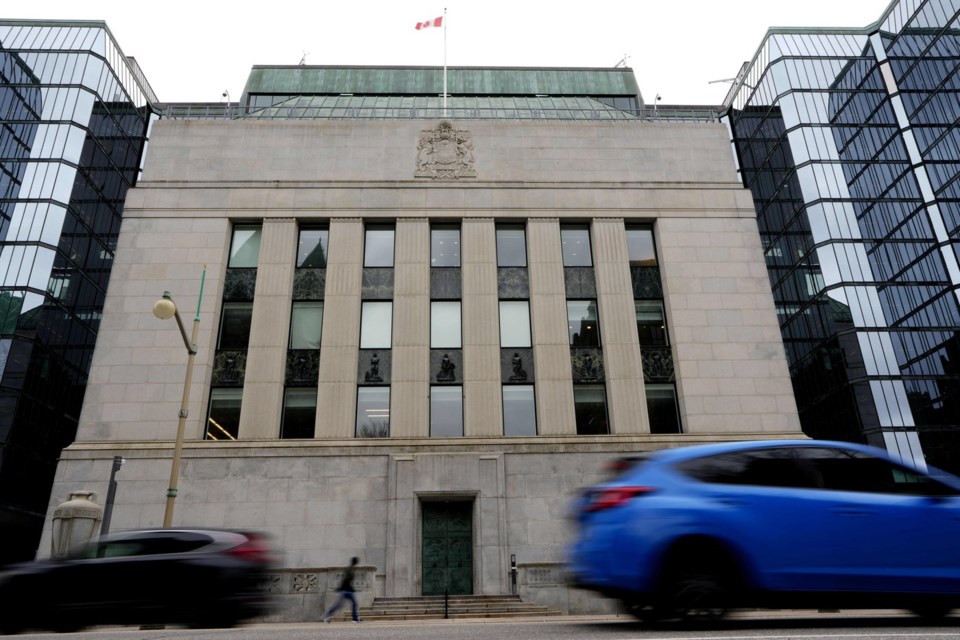OTTAWA — Signs that underlying inflation was picking up in April put the Bank of Canada in a tricky position ahead of its June interest rate decision, with some economists arguing a second straight pause is now more likely.
"It is going to make it a much more challenging backdrop for the Bank of Canada to continue cutting rates, at least in the near term," said Benjamin Reitzes, managing director of Canadian rates and macro strategist at BMO Capital Markets.
Statistics Canada on Tuesday reported a sharp slowing in the annual inflation rate — to 1.7 per cent in April from 2.3 per cent in March.
The end of the consumer carbon price at the start of April was largely to thank for the easing in the headline figure, StatCan reported.
With the carbon levy vanishing at the pumps and global oil prices falling from a mixture of reduced demand and a glut of supply, StatCan said gas prices fell 18.1 per cent annually in April. Natural gas prices also saw double-digit declines last month.
The only province that didn’t experience a slowdown in inflation was Quebec, a province that has its own cap-and-trade system and therefore didn’t benefit from the end of the federal carbon price regime.
But some economists pointed out Tuesday that the falling headline figure masks signs of trouble elsewhere in the consumer price index.
Excluding energy from the consumer price index, StatCan said inflation would have come in at 2.9 per cent for April – an increase from 2.5 per cent for the same calculation in March.
"If you look a little bit deeper, the inflation numbers were unfortunately stronger than most everybody expected," Reitzes said.
While the headline inflation figures showed signs of easing in April, the Bank of Canada's preferred measures of core inflation, which strip out influences like the end of the carbon carbon price, accelerated to top three per cent in the month.
The April inflation figures come a little more than two weeks before the Bank of Canada is set to make its next interest rate decision on June 4.
The central bank held its policy rate steady at 2.75 per cent last month, saying then that it needed more time to see how Canada’s trade war with the United States was impacting the economy.
Financial market odds of an interest rate cut in June fell to just under 35 per cent Tuesday afternoon — a flip-flop from roughly 64 per cent at the end of last week, according to LSEG Data & Analytics.
CIBC senior economist Andrew Grantham said in a note to clients Tuesday that the central bank will be watching the core inflation trend carefully, alongside indications that the tariff dispute was starting to bite Canada's labour market.
StatCan reported earlier this month that the national unemployment rate rose to 6.9 per cent in April as the trade-sensitive manufacturing sector took a hit.
"Signs of renewed weakening in the economy on one hand, as shown by the latest employment data, but stronger core inflation on the other makes for a tough decision for the Bank of Canada at its early June meeting," Grantham said.
The central bank typically raises its policy rate to tamp down price pressures and lowers it to encourage economic growth; policymakers have made clear they can't effectively lean against both a slowing economy and a resurgence in inflation at the same time in a trade war.
The Bank of Canada's mandate is to keep annual inflation at two per cent, and that figure has floated in the broader one-to-three per cent range for well over a year now.
But Reitzes said, cracks in the economy aside, the April inflation data does not support additional cuts.
"We are not there. Inflation has gone the wrong way. And that is an issue for (monetary policymakers)," he said. "If they want to maintain their credibility, they should be keeping rates steady."
TD Bank senior economist Andrew Hencic said in a note that signs of a resurgence in core inflation might mean that the tariff hit could be showing up sooner than anticipated in the price data.
Hencic said the April inflation report "complicates" the Bank of Canada's decision making, but added that TD sees two additional interest rate cuts from the central bank in 2025.
There's still one major economic release on the docket before the Bank of Canada has to make a decision: next week, StatCan will report on how the economy fared in the first quarter of the year and give a peek at how April played out as well.
If data comes in showing the trade dispute continues to strain the Canadian economy, Reitzes said it's "reasonable" to expect more rate cuts this year.
Grantham said in his note that if next week's GDP report suggests the economy was heading toward a contraction in the second quarter, that could be enough to push the central bank to a cut on June 4.
Elsewhere, prices for food bought from stores rose 3.8 per cent last month, StatCan said, accelerating from 3.2 per cent in March.
On an annual basis, prices for fresh vegetables rose 3.7 per cent, the cost of fresh and frozen beef was up 16.2 per cent and prices of coffee and tea rose 13.4 per cent, the agency said.
Grocery store inflation has now outpaced the overall consumer price index for three months in a row.
Reitzes said he had thought some downward pressure from the end of the consumer carbon price would start to feed through into food costs, but he said any relief could be offset by Canada's tariff battle with the United States as well as a weaker loonie.
Canadian travellers also felt the pinch as travel tour prices rose 3.7 per cent monthly in April, reversing course after a decline of eight per cent in March.
This report by The Canadian Press was first published May 20, 2025.
Craig Lord, The Canadian Press




